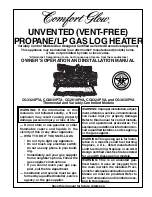
44
the ash pan. The cover plate is raised approx. 8 mm above the grate, thus ensuring that the automatically
controlled primary combustion air is distributed evenly at the base of the combustion chamber.
Chimney
The chimney is the “engine” of the stove and it is crucial for the functioning of the woodburning stove.
The chimney draft provides a partial vacuum in the stove. This vacuum removes the smoke from the stove,
sucks air through the dampers for the so-called glass pane rinse which keeps the glass free of soot, and
sucks in air through both primary and secondary dampers for the combustion.
The chimney draft is created by the differences in temperature inside and outside the chimney. The higher the
temperature within the chimney, the greater the draft. It is crucial, therefore, that the chimney is warmed up
properly before closing the damper and limiting the combustion in the stove (a brick chimney takes longer to
warm up than a steel chimney). On days where the weather and wind conditions create insufficient draught
inside the chimney, it is even more important to warm up the chimney as quickly as possible. The trick is to
quickly get some flames going. Split the wood into extra fine pieces, use an extra firelighter, etc.
If the stove has not been used for a longer period, it is important to check that the chimney pipe is not blocked.
It is possible to connect several devices to the same chimney. However, it is important to first check the
applicable rules.
Even a good chimney can function badly if it is not used correctly. Similarly, a bad chimney may function
well if used correctly.
Chimney sweeping
To prevent the risk of chimney fires, the chimney must be cleaned every year. The flue duct and the smoke
chamber above the baffle plate must be cleaned together with the chimney. If the chimney is too tall to
be cleaned from above, it must be equipped with a soot door.
In case of a chimney fire, close all dampers and call the firefighters. Before any further use, have the
chimney checked by the chimney sweeper.
F
IrIng
manual
-
wood
When you light the stove for the first time it should not be stoked excessively as all the materials must
be given time to adapt to the effects of heat. The lacquer will be fully hardened after the stove has been
used, and the door and the ashpan should be opened very carefully as there will otherwise be a risk that
the gaskets will stick to the lacquer. In addition the lacquer may initially give off an unpleasant odour, so
make sure that the room is well ventilated.
Tips about fuel
Approved fuel types
The wood burning stove is EN approved for combustion of wood only. It is recommended to use dried
chopped wood with a water content of a maximum of 20%. Stoking a fire with wet wood results in soot,
environmental problems, and a less efficient fuel economy.
Recommended wood types
All types of wood, for instance birch, beech, oak, elm, ash, conifers, and fruit trees can be used as fuel
in your wood burning stove. The great difference is not in the fuel value, but in the weight of the wood
types per cubic metre. Since beech weighs more per cubic metre than for instance common spruce, it
will take more common spruce to produce the same amount of heat that you would get from a cubic
metre of beech.
Summary of Contents for 3420
Page 2: ...2 ...
Page 4: ...4 B C A 3 1 1 4 45 4 3 2 1 D 9 11 10 17 1 6 5 7 8 2 3 15 4 16 4 3 14 12 13 11 12 14 14 15 ...
Page 5: ...5 F 6 2 1 3 4 5 G 3 0 E 1 ...
Page 6: ...6 H ...
Page 38: ...38 ...
Page 39: ...39 ...
Page 40: ......
Page 51: ......
Page 52: ...www hwam com ...









































